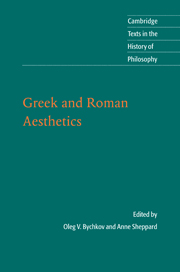Book contents
- Frontmatter
- Contents
- Preface
- Introduction
- Chronology
- Further reading
- Note on the texts and the translations
- Greek and Roman Aesthetics
- Gorgias
- Plato
- Xenophon
- Aristotle
- Philodemus
- Cicero
- Seneca
- Longinus
- Philostratus
- Philostratus the Younger
- Aristides Quintilianus
- Plotinus
- Augustine
- Proclus
- Index
- CAMBRIDGE TEXTS IN THE HISTORY OF PHILOSOPHY
Proclus
Published online by Cambridge University Press: 05 June 2012
- Frontmatter
- Contents
- Preface
- Introduction
- Chronology
- Further reading
- Note on the texts and the translations
- Greek and Roman Aesthetics
- Gorgias
- Plato
- Xenophon
- Aristotle
- Philodemus
- Cicero
- Seneca
- Longinus
- Philostratus
- Philostratus the Younger
- Aristides Quintilianus
- Plotinus
- Augustine
- Proclus
- Index
- CAMBRIDGE TEXTS IN THE HISTORY OF PHILOSOPHY
Summary
Commentary on the Timaeus
1,265.18–26
So too Phidias who made the statue of Zeus did not look at something that has come to be but arrived at a notion of the Homeric Zeus. If he had actually been able to reach the intellectual god himself, clearly his own work would have been a finer achievement. Beauty, or the lack of it, comes to the image from the model, likeness or unlikeness to the archetype comes from the sculptor. ‘Image’ is used of both, both the copy of the model and the work and product of the sculptor.
Commentary on the Republic
1,177.7–179.32
Let us turn next to the discussion of poetry and consider what types of poetry there are according to Plato, what type he had in mind when he expounded his criticisms of poetry in the tenth book of the Republic, and finally how even here homer is shown to be exempt from the criticisms which apply to most poets. To make this clear also, let us begin teaching about this with the following point: we say that, speaking generally, there are three kinds of life in the soul. The best and most perfect kind is that in which the soul is joined to the gods and lives the life that is most closely akin to them and united with them in extreme similarity: it belongs not to itself but to them, surpassing its own intellect, awakening in itself the ineffable symbol of the gods' unitary existence and joining like with like, its own light to the light of the gods and the most unitary aspect of its own being and life to the One which is beyond all being and life.
- Type
- Chapter
- Information
- Greek and Roman Aesthetics , pp. 235 - 243Publisher: Cambridge University PressPrint publication year: 2010

